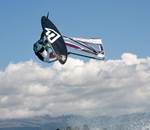Spread-tow fabric secures ultralight aircraft’s weight goal
Shark Aero (Hlboké, Slovak Republic) designed its composite-airframed, single-seat prototype ultralight aircraft (ULA), the Shark UL, with spread-tow carbon fiber woven fabrics to reduce weight.
Startup general aviation manufacturer Shark Aero (Hlboké, Slovak Republic) designed its composite-airframed, single-seat prototype ultralight aircraft (ULA), the Shark UL, with a view toward reducing weight. European ULA aircraft (also known in Europe as microlights) are limited by the Joint Aviation Authorities (JAR-1) to a maximum empty weight of only 300 kg/660 lb, but they are allowed a top speed of 300 kmh (186 mph). For comparison, single-seat ultralights in the U.S. are limited to a maximum of 101 kmh/63 mph (two-place trainers can go a bit faster, 138 kmh/86 mph). Therefore, a key design imperative was low airframe weight in exchange for greater air speed. The anticipated side benefits included more responsive flight controls, a higher payload-carrying capability, reduced takeoff and landing distances, a better climb rate and improved fuel efficiency.
After a first prototype failed to hit the design weight goals, the company approached Oxeon (Borås, Sweden) in late 2008 to test trademarked TeXtreme Spread Tow woven carbon fabrics. The fabrics are made in a novel process in which carbon tows are spread to form thin, flat tapes. Then, the tapes are woven together to make very thin fabrics with virtually no fiber crimp (the weave is visible in the photo at right). The resulting reinforcement has mechanical properties similar to a traditional cross-ply unidirectional material, but achieves those properties with less weight.
Shark Aero tested the mechanical properties of several TeXtreme variants and found that TeXtreme offers mechanical and process advantages when they are compared to conventional carbon fiber-based reinforcement materials. In particular, composite parts could be redesigned to reduce weight without sacrificing essential strength. Further, the surface smoothness afforded by TeXtreme tape eliminated the need for an outer protective layer of glass fabric, cutting a labor-intensive step in the manufacturing process. As a result, Shark replaced the plane’s 200-g/m2 and 90-g/m2 baseline fabrics with 160-g/m2 and 80-g/m2 TeXtreme fabrics, respectively.
“By switching to TeXtreme, we saved 50 kg [110 lb] in total on the aircraft,” reports Shark Aero CEO Vladimir Pekar. He also notes that “on average, the weight of smaller parts, such as the stabilizer, elevator, rudder, spinner and landing gear doors, have been reduced by 60 percent. Weight savings of this magnitude allow us to build a faster airplane.”
The plane’s fuselage now weighs just 41 kg/90 lb, which is 25 kg/55 lb less than the prototype made using conventional carbon fiber fabrics.
Thanks to the lighter spread-tow fabrics, the program has been a success. “By switching to TeXtreme and performing finite element modeling,” Pekar says, “the unexpected 25-kg weight savings allowed us to meet the maximum empty weight of 300 kg/661 lb for a single-seat ULA and at the same time improve many crucial flight features.”
Shark UL airplanes are presently competing for world speed records and are aiming to reach the ULA speed limit in the near future.
Related Content
-
The lessons behind OceanGate
Carbon fiber composites faced much criticism in the wake of the OceanGate submersible accident. CW’s publisher Jeff Sloan explains that it’s not that simple.
-
Cryo-compressed hydrogen, the best solution for storage and refueling stations?
Cryomotive’s CRYOGAS solution claims the highest storage density, lowest refueling cost and widest operating range without H2 losses while using one-fifth the carbon fiber required in compressed gas tanks.
-
Plant tour: Albany Engineered Composites, Rochester, N.H., U.S.
Efficient, high-quality, well-controlled composites manufacturing at volume is the mantra for this 3D weaving specialist.


















